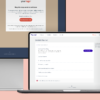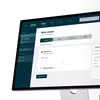
Next case study
Faster onboarding for Flexmail
Getting interested prospects to start using the platform and paying their first invoice used to take months. We helped reduce it to days.
Izix is a Brussels-based startup that focuses on parking management. They handle the logistics so vehicles can enter and exit parking lots. Their software ensures the parking gate opens, calculates occupancy and handles reservations. Izix does so for building owners, who have a complex parking lot with multiple floors, even multiple locations and multiple tenants within this building.

Bepark, the mother company of Izix, traditionally rented out parking spots from different (private) parking owners. After a while they started renting out unused spots through their website, becoming the Airbnb for unused parking spots. To service more clients and parking lots, Bepark decided to split off the software to manage all operations in its own company - Izix. The software of Izix allows drivers to open gates of selected parking, calculate where there are still parking spots available and much more. Bepark became a client of Izix.
Izix was struggling with the prioritisation process. The most urgent question was - what features should be built first?
01 / Step
Stakeholders had different visions of the right priorities.
02 / Step
Support teams were doing a lot of tedious manual work (like generating pricing reports on what each company had to pay for the usage of the parking spots).
03 / Step
The market was rapidly changing and they couldn't keep up.
04 / Step
Izix was rapidly growing and had 100 things to handle at once.

First, we looked into the current situation to understand how the existing product had been managed and what the targets were. That's where we found the biggest pressure.

We then focussed on creating clear communication lines. We instilled regular, clear communication moments, such as weekly insights checks and monthly updates based on discussions between CSM, CEO, CTO and product. We also visualised and created transparency for all stakeholders by visualising what we were working on in Productboard.
Lastly, we created a clear prioritisation process. We collected insights based on customer feedback from different teams such as sales and customer success. We scored the insights and categorised them into initiatives that we plotted on a roadmap over time. We highly focused on the communication of the roadmap and prioritisation process.

01 / Step
Every week we discussed changes requested for the roadmap. Every new initiative needed to have clear goals and reasons why it should be prioritised higher than what was already on the roadmap.
02 / Step
We kept communicating how decisions were made. Every quarter we explained to the full team how we prioritized.
04 / Step
We kept the feedback loop running with the current initiatives and the priorities, both from actual users and internal stakeholders.
The value of Smooth Sailing extends beyond the product and helps create a better management team.

Next case study
Getting interested prospects to start using the platform and paying their first invoice used to take months. We helped reduce it to days.